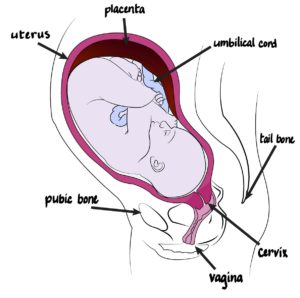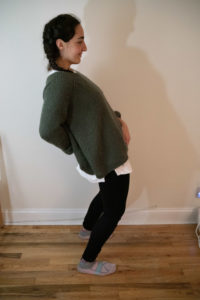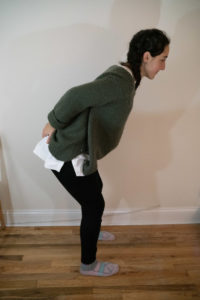There are many aspects of the childbirth process that have become so common that they are generally accepted as status quo. However, when we take a deeper look at the childbirth process, we realize they may not be the best options. One such area in particular is the position that we push in. The “standard” pushing position has been lying on the back (reclining) with legs bent and knees in stirrups (as you see in the image up top). This position enables doctors to see, maneuver, and perform interventions if necessary. However, PROnatal Advisory Board member Ashley Brichter, founder of Birthsmarter, explains why this position actually makes it more difficult to push. She then takes you on a step-by-step process to find the position that creates the greatest space for your little one to pass through. You might just be surprised by what it is.
Traveling Down the Birth Canal Requires SPACE
Before we can begin to discuss childbirth positions, it’s important to understand the journey your little one actually takes to navigate through the complex birth canal. Take a look at the image below, which shows the fetus inside the uterus. Notice that the baby’s head does NOT line up perfectly with the vaginal opening. Therefore, during labor, babies must perform a complex series of movements (known as the cardinal movements) to gradually descend through the pelvis for their much anticipated debut.

Seem complex? Amazingly, human babies are essentially pre-programmed to perform these movements, BUT they need space to do so. If we can maximize the amount of space a baby has within the pelvis, we can not only speed this process along but minimize the stress on muscles and tissues within the pelvic bowl (and therefore minimize the risk injury).
The challenge is that the “standard” labor position (reclining or lying down with knees bent and legs spread) essentially asks your body to push a baby UPHILL. In addition, this position makes the tailbone stick inward. This limits the amount of space that the baby has to move through the birth canal.
How do you maximize the space in your pelvis to encourage the baby’s rotation and descent? We have to find a position that creates the greatest space in the pelvis. The pelvis has four boney landmarks that determine the maximum circumference a baby has to fit through: front (pubic bone), back (tail bone), and sides (two sitz bones). We want to find a position that creates the greatest space between the front, back, and sides. Here are a few simple movements to find that position.
1. Find the Greatest Space Front to Back
Place one hand on your pubic bone (it’s very low down under the belly, right between your legs). Place your other hand on your tailbone. To find your tailbone, invite your hand to feel between the crease of your behind. It is often higher up than most people realize. You can walk your fingers all the way down the bottom of your spine until you reach the end – and/or lean back on your fingers, like in the image below, in order to feel it more.

Once you have fingers on the pubic bone and fingers on the tailbone, lean forward and feel the space between your fingers. Then lean back. In which direction do you have the most space between your fingers? Is it when you are leaning forward or leaning back?

If you’re trying this now, the answer should be obvious. The greatest space is when you are leaning forward.
2. Find the Greatest Space Side to Side
This is best done sitting down on the edge of a chair. Place your hands underneath your bum and you should feel your two sitz bones protruding down. If you don’t feel them right away wiggle side to side a bit. You should feel boney points digging into your hands. Now, spread your knees out wide (like you’re having a baby!). Feel the space between your fingers.

Then, bring your knees in close together (keeping your feet fairly separated).

In which position do you have more space between your sitz bones? With your knees together, feet apart, or your knees and feet wide? Surprisingly, you hopefully felt that there is more space when your knees are closer together than your feet.
Greatest Space = Leaning Forward, Knees Closer than Feet
WAIT. What? That’s right. Pretty different from the status quo. Most people deliver their babies on their backs with their knees spread wide because this is the most convenient position for doctors and hospital staff. However, if you are thinking about a physiological birth, looking for ways to possibly shorten your labor, or looking for ways to reduce the risk of tearing, give some serious through to positions that lend themselves to forward leaning and keeping knees closer than feet. You can do this several ways — standing and leaning on something, in quadruped (all 4s), or even side lying.
Of course, to be able to experiment with different pushing positions, you need to be in an environment that is supportive of this. To help you in asking the right questions, and making sure you are with a medical provider who aligns with your needs and values, check out this guide, Building Your Ultimate Birth Team, by Birthsmarter.
Train Safely and Effectively for the Event of Your Life
Interested in safe and effective workouts that prepare your body for the specific demands of pregnancy, childbirth, and the postpartum period? Explore our prenatal self-guided training programs. Just select the program that’s right for you based on your stage when starting, and you’ll be guided through a complete training program tailored to your stage. All programs include total body workouts, nutrition guidance, childbirth education, and weekly tips and education.
Or, for a more personalized approach, consider working with one of our PROnatal Personal Trainers.
Interested in Coaching Pre & Postnatal Clients?
Are you a fitness or health professional interested in working with pre & postnatal clients? Explore our Pre/Postnatal Professional Education. We offer a Specialist Course for trainers & coaches looking to specialize in this population and a Mini Course for group fitness instructors who just need the basics. We also offer simple training guides to get you started.
Affiliate Notification
This post contains an affiliate link for Birthsmarter. We may earn a commission from this link, but we only endorse companies that we have vetted and truly believe in.
